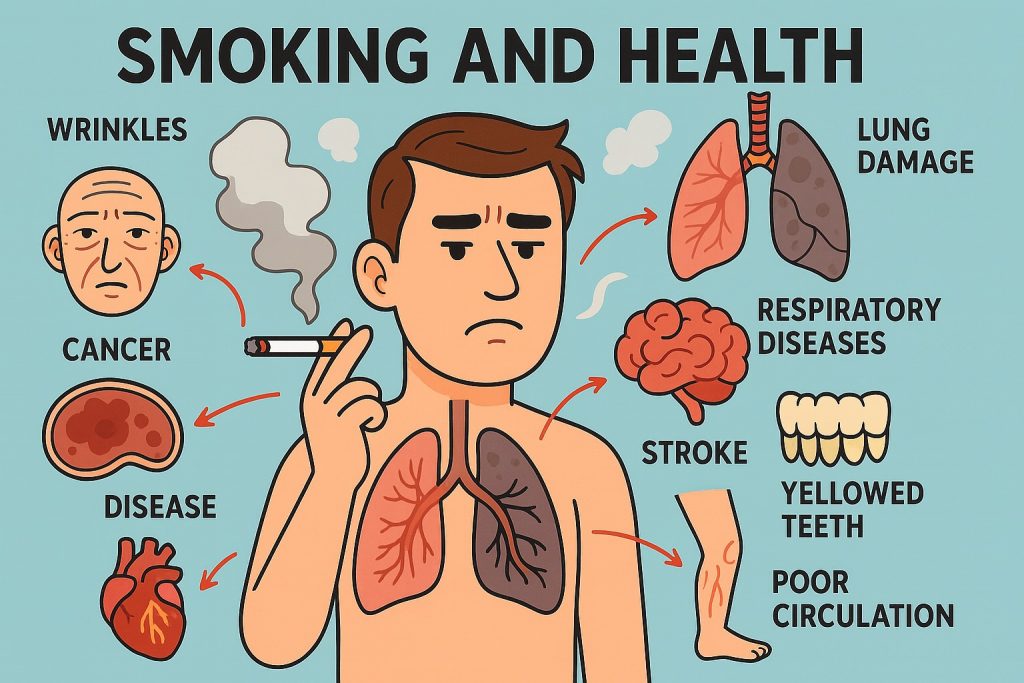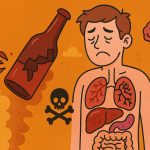When a person inhales cigarette smoke, they introduce over 7,000 chemicals into the body — including nicotine, tar, carbon monoxide, and formaldehyde. Many of these substances are toxic, and at least 70 are known carcinogens (cancer-causing agents).
The effects begin almost instantly: nicotine stimulates the brain within seconds, while carbon monoxide reduces oxygen in the blood. Over time, the body accumulates damage, leading to serious — often irreversible — health problems.
Damage to the Lungs and Respiratory System
Smoking is the leading cause of:
- Chronic obstructive pulmonary disease (COPD)
- Emphysema – destruction of air sacs in the lungs
- Chronic bronchitis – inflammation and mucus build-up
- Lung cancer – responsible for nearly 85% of all cases
Even occasional smoking or secondhand exposure significantly harms lung function, particularly in children and the elderly.
Heart and Blood Vessels: A Silent Attack
Nicotine and other chemicals in tobacco:
- Narrow blood vessels
- Raise blood pressure
- Increase blood clotting
These changes heighten the risk of:
- Heart attacks
- Stroke
- Atherosclerosis – buildup of plaque in arteries
- Peripheral artery disease
Smokers are 2–4 times more likely to develop heart disease than non-smokers.
Cancer: A Systemic Threat
While lung cancer is the most well-known consequence, smoking also increases the risk of cancer in:
- Mouth, throat, and esophagus
- Bladder and kidneys
- Stomach and pancreas
- Cervix and colon
Nicotine doesn’t directly cause cancer, but it makes quitting difficult, allowing other carcinogens to do long-term harm.
Impact on Appearance and Aging
Tobacco smoke accelerates aging by reducing blood flow and oxygen to the skin, leading to:
- Wrinkles and dull complexion
- Tooth decay and bad breath
- Yellowing of fingers and nails
Smoking also contributes to hair thinning, vision loss, and bone density reduction, making fractures more likely.
Smoking and Mental Health
Although some believe smoking reduces stress, nicotine addiction actually increases anxiety and mood swings. Over time, it can worsen:
- Depression
- Sleep disorders
- Cognitive decline
Withdrawal from nicotine often brings irritability and restlessness, reinforcing the habit and making quitting difficult.
Secondhand Smoke: Collateral Damage
Non-smokers exposed to secondhand smoke are at risk for:
- Respiratory infections
- Sudden infant death syndrome (SIDS)
- Heart disease and lung cancer
Children of smokers are more likely to develop asthma and ear infections.
Glossary
- Nicotine – The addictive stimulant in tobacco.
- Carcinogen – A substance capable of causing cancer.
- COPD – A group of lung diseases that block airflow.
- Atherosclerosis – Hardening and narrowing of the arteries.
- Secondhand smoke – Inhaled smoke from others’ tobacco use.


